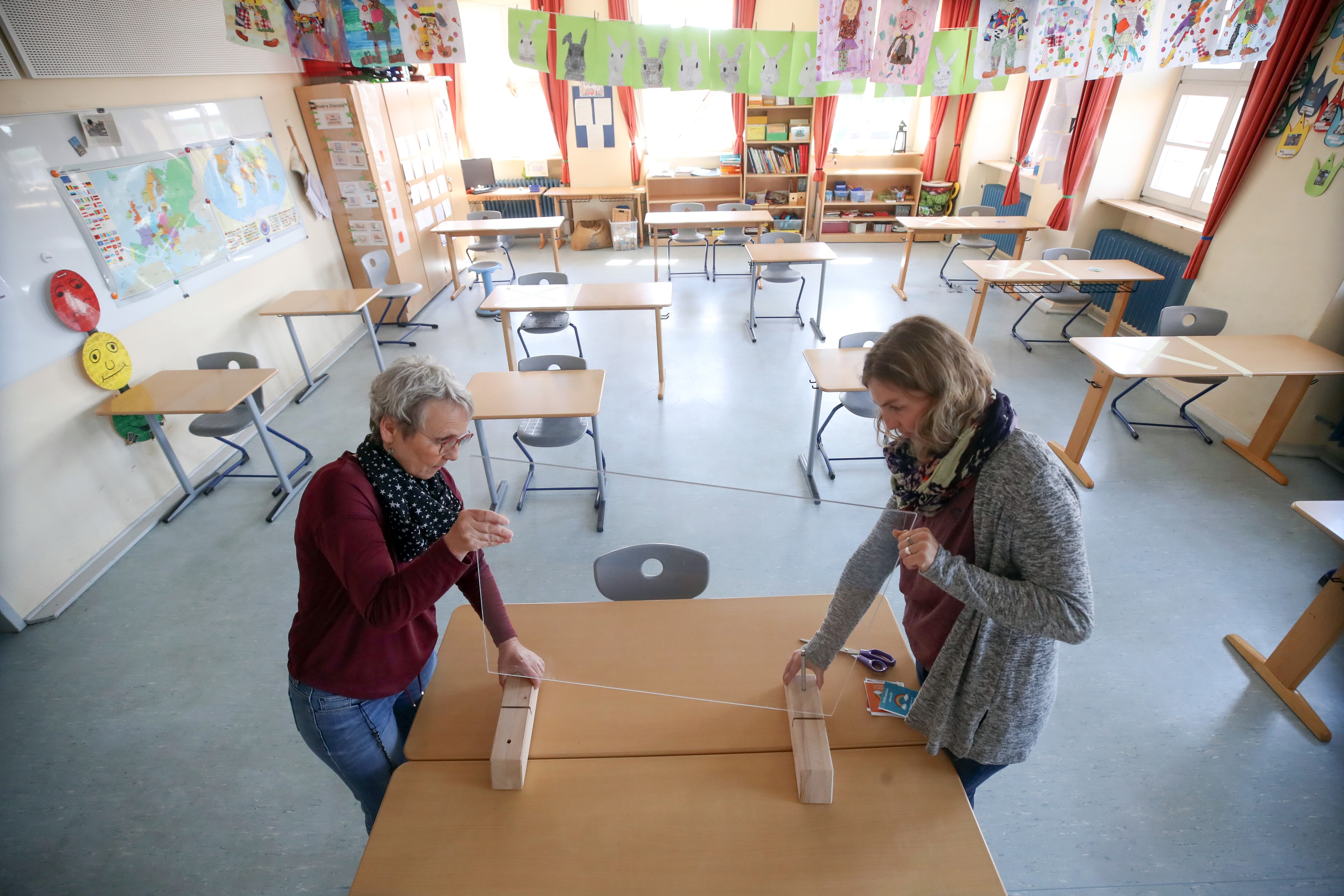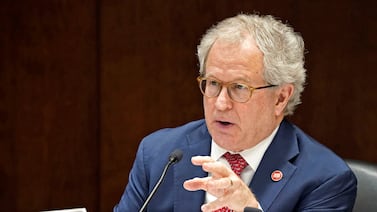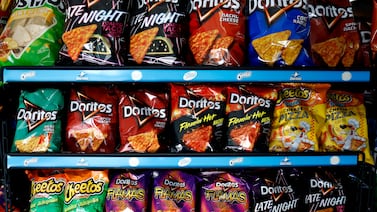Outdoor tents. Plexiglass barriers. Bus aides to supervise social distancing. Voice amplification systems to counter the muffling effect of face masks. Hands-free bathroom fixtures.
These are among the blueprints for in-person classes at wealthier school districts in Illinois this fall.
But they’re hardly the norm.
As school districts release reopening plans, stark differences are starting to emerge — differences that could affect the quality of education students receive and the conditions in which they learn. A Chalkbeat analysis of more than 70 reopening plans showed that while some wealthier districts are bankrolling expensive changes to their buildings and staff to safeguard against the coronavirus, financially strapped districts are planning to make the most of low-budget precautions such as hand sanitizer and anti-bacterial wipes.
When those plans can be executed is still up in the air. With COVID-19 cases resurging in many parts of the state, some districts are scrambling to revise their plans and delaying in-person instruction. But the preparations could be critical for when students do return to school buildings, and budgets are playing a big part in how comprehensive the preparations are.
Before the pandemic, Illinois consistently reported among states with the largest school funding gaps between wealthier and poorer districts, an issue a 2017 revamp of the state funding law started to address. But with the coronavirus pandemic cutting state budgets, experts expect little headway to be made in closing those gaps in the coming year.
“Districts that don’t have enough money are continuing to scrape by the best they can. And they just won’t be able to offer their students the same curricular variety, that same class size, the same support system, that those wealthier districts can,” Jessica Handy, the government affairs director at Stand for Children, an education advocacy group, said.
For this year’s reopening, the state Board of Education said that schools can hold in-person classes with restrictions, but it has left most of the details up to local school districts. Districts across income levels will tentatively implement the same baseline safety precautions: distance between desks, pre-packed lunches, limited use of lockers, and masks for all.
But that’s where many of the similarities end.
Wealthier districts refit campuses
District leaders are tasked with building a plan that both hedges the risk of infections and facilitates high-quality education. For the wealthier districts, that means developing creative strategies, even if it means an expensive overhaul of facilities.
In Highland Park, North Shore School District 112 will use outdoor tents as learning spaces. The district is assigned a Tier 4 status, a state classification awarded to the wealthiest districts that are at least at 100% financial capacity to meet student needs.
District 112, which serves fewer than 3,900 students across 12 schools, is arranging for at least two large tents per campus. Only a handful of districts in the state have even considered outdoor tents yet, but Superintendent Michael Lubelfeld said students’ needs justify the extra costs.
“With millions of dollars, we are to go beyond what is required … because it’s the right thing to do,” Lubelfeld said at a July board meeting. North Shore has allocated $1.2 million for COVID-19 related expenses, and is still expecting a balanced budget for fiscal year 2020.
Arlington Heights Township High School District 214, which is at a 94% financial capacity to meet student needs, has installed a voice amplification system in classrooms, in part so that teachers wearing masks can be heard clearly. “We did not want to put any student who may be further from their teacher at a disadvantage,” Superintendent David R. Schuler wrote to families last month.
District 214 will start the school year with all-remote learning, but students and staff can also expect video cameras when they return to school buildings. The cameras allow students who choose to continue with remote learning classes to participate in classes live. Live instruction offers learners advantages like frequent interaction with teachers and immediate feedback.
At the affluent Glenbrook School District 225, where students could return to school buildings as soon as Sept. 8., district leaders plan to overhaul bathroom fixtures and equipment to minimize contact. Manual toilet flush handles, soap dispensers, and faucets will all be replaced with automatic mechanisms.
And while many districts have canceled in-person music classes for safety, Glenbrook plans to install customized plexiglass sheets between the music director and students.
Most reopening plans aim to mitigate hallway congestion through staggered bell schedules and assigned exits and entrances. But the wealthier Lisle Community Unit School District tentatively plans to retrofit two old facilities.
Conservative precautions for cash-strapped districts
For financially strapped districts, returning to school amid the pandemic could mean giving up in-person music classes, buying low-cost cleaning supplies in bulk, and settling for limited real-time instruction.
Chicago Public Schools said it plans to hire 400 additional custodians, though the district has more than 600 schools. The district has also bought 40,000 containers of disinfectant wipes for classrooms. But with about 22,500 teachers, that amounts to less than 2 containers of wipes per educator.
Chicago will start the school year with remote education only, it said this week, but district officials will aim to start the second quarter with some in-person learning if COVID-19 cases go back down. One question weighing on families and educators has been how the district can boost sanitation and safety protocols in buildings with aging ventilation systems.
“There are no clean HVAC systems in every single school,” Maximilian Cole, a special education teacher, said in a call to move to remote learning early this week. “Cleanliness is not in every single school.”
In Waukegan Public Schools, students will also start the school year with remote instruction and tentatively plan to return to in-person instruction later in the fall. As in Chicago, enhanced sanitation measures focus on making hand sanitizer dispensers and disinfectant bottles more readily available, as well as increased cleaning of doorknobs, staircases, and railings.
The district, one of the less affluent in the state, has also been hit particularly hard by COVID-19. The city of Waukegan makes up 31% of coronavirus cases in Lake County, but only 12% of the county’s population.
At Rockford Public Schools, when in-person classes resume in early September, teachers will not be able to livestream classes and all-remote students will have to rely mostly on audio or video recordings. Rockford is also among districts with the lowest financial capacity, according to the state’s tier system. Live instruction will be mostly limited to small group meetings and one-on-one conferences for feedback.
How will districts pay for new health and safety expenses?
As district leaders reimagine learning for the fall, they also face the daunting challenge of fitting unexpected costs into their budgets.
The federal government set aside some emergency aid for schools in its first stimulus package this past spring — Illinois schools were set to receive nearly $700 million — but district leaders have consistently said that their costs will exceed the rescue funds they receive.
The state will hold education funding mostly flat this year, adding to the financial squeeze.
At Evanston/Skokie School District 65, a more affluent district that serves nearly 7,000 students, administrators are projecting nearly $3.4 million in COVID-19 related expenses this school year. The district is also projecting its revenues will be about $3.5 million lower due to the pandemic, according to a June finance committee meeting.
Glenbrook School District 225, where the new hands-free bathroom fixtures and plexiglass barriers are going in, is still expecting a balanced budget. The district has tentatively budgeted an additional $500,000 on coronavirus-related expenses in the 2020-21 fiscal year, but remains in a “financially strong” position, according to a tentative budget report. The school district is 94.6% locally funded, primarily through property taxes.
Public school revenue is tied to property wealth, which means wealthier districts have more to spend.
Questions about finances weigh heavier for administrators at lower-income and already underfunded districts like Chicago Public Schools, said Handy, at Stand for Children.
CPS chief Janice Jackson told Chalkbeat in a July interview that the district will not skimp on safety because of budget pressures. “Like everyone, I worry about the financial implications of COVID, not just on the school system, but on our economy. But I want to be clear that our planning is not focused on that. We will do whatever it takes in order to educate our students and do this safely,” she said.
In Waukegan, the district has already started to look into different means of financial support, through a relief grant and lines of credit.
“It’s definitely going to be a challenge for districts that were already cash strapped, who are now having to think about retrofitting their classrooms and managing social distancing,” Handy said. “There’s that sort of thing that we don’t like to think about, which is how are we going to pay for this.”





